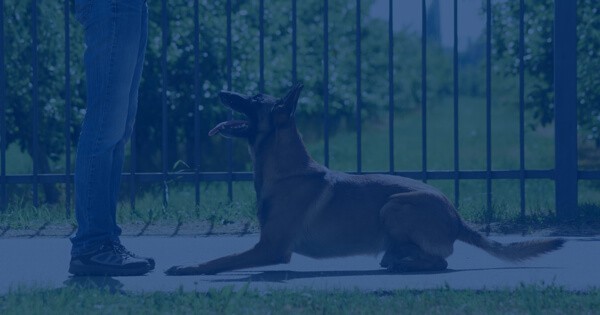When it comes to choosing a personal protection dog trainer, look for one with an excellent reputation who is trusted by homeowners, law enforcement, and military alike.
Here are the top 5 things to look for in a dog training professional.
1. Obedience Training
This can be done through obedience exercises as well as on an obedience course. Training a dog to obey commands is really the foundation on which everything else is built. Especially for police departments and the military, it is vital that a K9 can obey commands in any situation, even with multiple distractions happening at once.
Part of obedience training involves teaching the dog not to follow its instinct to eat the treat on the floor in front of him, but instead to wait patiently for his master’s command. Self-control and obedience exercises should be practiced over and over with the dog until the results are impeccable.
Tip: Look for a trainer who not only makes progress with your dog but can also adapt to the dog’s learning style and response to rewards.
2.Multiple Types of Command Cues
Police and military dogs need to be able to understand and obey verbal cues as well as hand gestures. In situations such as a raid, trained guard dogs must be able to know how to take commands without any sound. For example, a trainer with experience in German Shepherd tactical training should have no trouble teaching your dog multiple types of command cues.
3. Teaching Socialization
A guard dog that has no manners around other dogs or people can be a nuisance, to say the least. Often times, military and police K9 officers take their work dogs home in the evening, so it is imperative that a trainer work is able to properly socialize it for both environments.
Tip: Ask your K9 obedience trainer what types of socializing he or she teaches. Also, inquire about how those social skills will help you utilize the dog for both professional use and personal enjoyment.
4. Positive Training Methods
A study done in Belgium with 33 dogs and their military owners looked at how harsh punishment affects dog performance. It was found that positive reinforcement (such as a pat on the pat, smile, or a treat) for compliance by the dog produced far better results than using punishment for non-compliance.
They also found that for guard dog trainers who used positive training methodology, the relationship between dog and master was greatly improved over those who used negative techniques.
5. Enjoyable Training Sessions
The CIA ranked this trait as the most important aspect of military dog training. Their lead trainer suggests making training fun by starting off with a game, a pleasant tone of voice, or food. The idea behind this technique is to draw the dog into the training activities rather than forcing it, which can potentially yield less than productive results for both the dog and the trainer.
Belgian Malinois K9 Unit and German Shepherd Police Canines for Sale
Steve Scott is a personal guard dog trainer who has been trusted for over 15 years to provide protection dogs for use in law enforcement, military, and in private homes.
He trains puppies and dogs that will not only work tirelessly alongside you but will also give you peace of mind. Contact Steve today at Scotts K9: (919) 939-6003.
